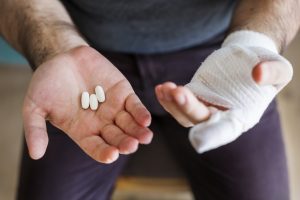Burn Pain: Understand and Conquer It

Burn injuries can be painful. Burn pain is a major concern for the patient and their family. Patients can feel pain in different phases of treatments and recovery. An important component of burn management is to minimise pain. This post aims to shed some lights on the nature and management of burn pain in hospital and in the community.

Acute
In the hospital, pain may be caused by the burn itself; procedures such as dressing changes or therapy; or operations where burned tissue is removed and replaced. The staff from specialised acute pain service frequently review patients’ pain management plans to help manage their pain.
Usually, patients receive a combination of different pain medication tailored to individual patients. Common types of pain medications used include paracetamol, anti-inflammatory medications (eg ibuprofen) and opiates. They can be given orally (as tablets or syrups), or intravenously (through a drip). As the pain changes or reduces, the staff review and alter these medications.
Patients can also breathe pain-relieving gas such as nitrous oxide (‘happy gas’) or methoxyfluorane (‘green whistle’) during dressing changes.
Specialist anaesthetists perform general anaesthesia for most burn operations, and also pain relief for both during and after the operation. In addition to standard pain medications, specialists can administer long-acting local anaesthetics to numb both the burned areas and donor sites.
 Chronic
Chronic
Although the burnt area is healing, pain can persist and become an obstacle to returning to normal everyday life.
Burn survivors may continue to feel pain or abnormal sensations due to nerve sensitivity. These sensations include itching, tingling, pins and needles, numbness, coldness, hot flushing, burning and even electrical shock sensations. They can be more marked after burns associated with electrical injury.
Management of chronic pain after a burn is by early identification and treatment of neuropathic pain with a holistic approach. A good management plan incorporates both physical and psychological rehabilitation to address the possible aftermaths, such as depression or post-traumatic stress disorder.
Community
When a patient is leaving the hospital the multidisciplinary team (doctors, physiotherapists, occupational therapists, psychologists, dietitians and pain management team) get together to make a plan for the patient. Good pain management involves coordination between patients, families and these professionals. For example, well-balanced diet, physical exercise, psychological assistance, lifestyle modification, wound management and medication can improve pain management. Patients may be linked to the hospital where their burns were treated or community services for these supports
As healing takes place pain usually lessens, but in some cases pain can become an ongoing problem. If this occurs, consulting with a burns doctor or GP. They may make a referral to a specialist pain service.
Outpatient management
For those patients who are not admitted but treated as outpatients it is also important for their pain to be well managed. Pre-medication (‘pre-med’) is prescribed for before the procedure. It is important that the patient or carer give this medication as prescribed to give it time to work before the procedure.
If your pain isn’t well managed
Discussed with your burn team. They can work with you to address the issue.
You can also speak to your local GP, especially if you are an outpatient.
Online Resources
- Chronic Pain Australia
- Pain Australia
- Australian Pain Management Association
- NPS Medicines WiseNational Prescribers Service
- ACI Pain Management Resources
Gratitude to Dr Kar-Soon Lim, Dr Winnie Hong, and Sandra Tutt